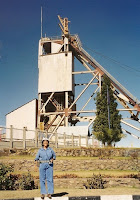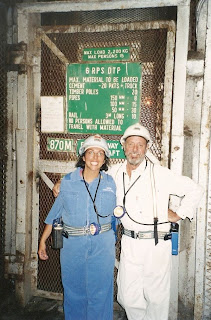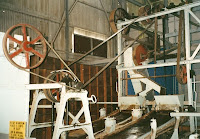
One thing that South Africa is known for is its mining of both diamonds and gold. Kimberley is the location of South Africa's first diamond mine, which was the original headquarters of the now world famous De Beers. Diamonds were first discovered in Kimberley in 1867, but it was not until 1870 that Nicolaas de Beers found diamonds on his farm. News of the existence of diamonds caused an absolute frenzy with hundreds of families taking over Kimberley in search of diamonds. Today there are 6 major diamond mines in South Africa. I was fortunate to be able to go down into the Kimberley Mine.

When I say that I went down into the Kimberley Mine, I mean that I went 870 meters (2,854 feet) or a little over half a mile below the surface. Before I could do that I needed to gear up and go through some safety procedures. I also had to sign a paper stating that anything found in the mine is the property of De Beers (Darn!!).
I was told a mine usually takes about 7 years to build and then about 10 years to mine. The diamonds are found in kimberlite rock. Through pressure and dynamite the rocks fall. Large machinery is used to scoop up the large rocks and place them into a barrel. The barrel is pushed down the tracks to a conveyor belt. The conveyor belt moves the large rocks into a crushing machine, where the large rocks become small stones. Another conveyor belt catches the stones and moves them to the top of the mine.
My tour guide was very excited for me to hear the dynamite. He could not wait to see my reaction. Unfortunately or fortunately for me one of the main conveyor belts broke. Production had to stop until the belt was fixed, which would take several hours. Therefore, I did not get to experience a dynamite blast underground only hundreds of feet away from me. One part of the tour that I found fascinating was the emergency procedures. When dynamite is set off, there is always a potential for catastrophe. There can also be a fire underground, an earthquake, or water seepage that can cause a mudslide. When these things happen, you have to run like a maniac to safety. When you are half a mile underground, you are not likely to make it to the elevator in time to get out. There are many, many tunnels. It is a maze down there. Therefore, there are several rescue rooms. If you can not get to the elevator, you are to try and get to one of the rescue rooms. One of the challenges is that the lights underground may go out. It could be pitch black. You may not be able to see your hand in front of you. With this in mind the mine has hanging poles that are there to basically smack you in the face. When you hit one of these, you know the door to the rescue room is on one of the sides. Once safely inside of the resouce room, you will find food, water, lamps, oxygen, and a radio communication system. You can survive in a rescue room for many days.
One part of the tour that I found fascinating was the emergency procedures. When dynamite is set off, there is always a potential for catastrophe. There can also be a fire underground, an earthquake, or water seepage that can cause a mudslide. When these things happen, you have to run like a maniac to safety. When you are half a mile underground, you are not likely to make it to the elevator in time to get out. There are many, many tunnels. It is a maze down there. Therefore, there are several rescue rooms. If you can not get to the elevator, you are to try and get to one of the rescue rooms. One of the challenges is that the lights underground may go out. It could be pitch black. You may not be able to see your hand in front of you. With this in mind the mine has hanging poles that are there to basically smack you in the face. When you hit one of these, you know the door to the rescue room is on one of the sides. Once safely inside of the resouce room, you will find food, water, lamps, oxygen, and a radio communication system. You can survive in a rescue room for many days.
 Once my tour was over, I went to the museum that explains the diamond mining process in detail. After the stones are brought to the surface, the stones are rinsed. Next the stones are placed on a special machine. This machine has a belt with oil on it. The diamonds stick to the oily belt and all other sediments fall off. This is how the diamonds get separated from the other materials.
Once my tour was over, I went to the museum that explains the diamond mining process in detail. After the stones are brought to the surface, the stones are rinsed. Next the stones are placed on a special machine. This machine has a belt with oil on it. The diamonds stick to the oily belt and all other sediments fall off. This is how the diamonds get separated from the other materials. Once the diamond is separated from the other sediments, it is sent off to someone to cut it into jewelry. It usually takes about a 12 foot by 12 foot room worth of rock and dirt to mine a single carat of diamond. That's a lot of rock and dirt for just 1 wedding ring.
Once the diamond is separated from the other sediments, it is sent off to someone to cut it into jewelry. It usually takes about a 12 foot by 12 foot room worth of rock and dirt to mine a single carat of diamond. That's a lot of rock and dirt for just 1 wedding ring.In addition to the diamond mine tour and the museum, there is an outdoor historic small town that can be walked through in Kimberley. It looks like a town from an old western. It has a bar as well as places that people would go to weigh their diamonds and stake their claim. It was interesting to walk through and try to imagine what it was like back in 1890 or so.
For me Kimberley, South Africa was completely out of my way and was not part of my original plan. I did not have a car and Kimberley was in the opposite direction of Kruger National Park. I definitely think I made the right decision to hop on the bus and take a couple of days to view the diamond mine. It was well worth a visit to see something I would never get to see in the States.

No comments:
Post a Comment